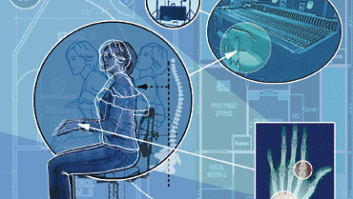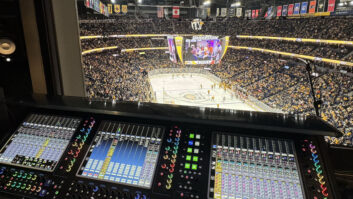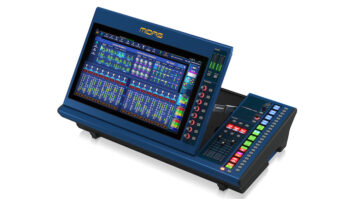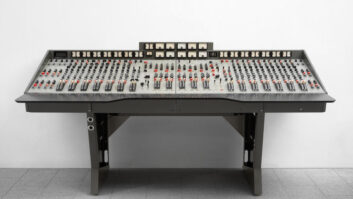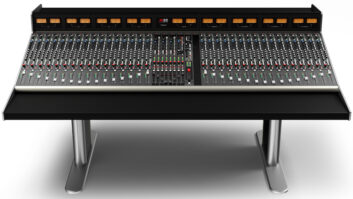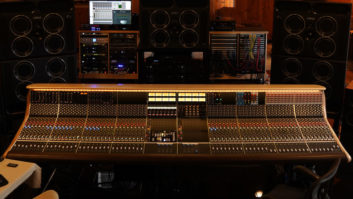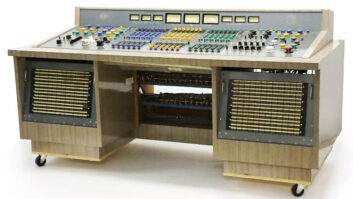Those days are gone…
By which, I do not mean that we should return to “the good old days.”
Nostalgia notwithstanding, these are the good old days (and they’re getting better), and the old consoles were a royal pain in the patootie. They were a pain before sessions, during sessions and after sessions.
For anything bigger than a rhythm section, the mixer had to spend a good deal of time working out how to get all those players on all those mics through pitifully few channels, and having management that, spend more time actually mixing the band, as the rotary faders were spaced about four inches apart, allowing two per hand. Things got really busy from time to time, especially as we didn’t limit the vocals, which required a half-hand of their own. When the brass went to mutes, the reeds went to flutes and the rhythm guitar went to fills, the mixer went to the moon. It is a fact that a mixer can get into the music a little better with rotary faders than with straight liners, but rotaries will work you to death.
To make things even more interesting, the early recording consoles had virtually no equalization, habitually developed noisy tubes (sometimes during a session), and engineers had to clean and regrease the fader every morning and sometimes between gigs to reduce the switching ticks between steps. We went through about a pound of Vaseline each month keeping the faders clean and still got little ticks on soft passages. Pain.
When you combine the aforementioned horrors with the absolute certainty of a little hum and an amazing amount of heat from the tubes, you get a working environment suitable for only the very brave or the very desperate. Usually both. I occasionally wonder not how we managed to record anything in the good old days, but why. It was a hell of a lot of work just to get through a session, let alone get it good. Probably the only thing that saved us was “good old” monaural. At least nobody could listen to each channel by itself and find out how bad the stuff really sounded.
Actually, the overall sound was generally pretty decent and sometimes terrific, but taken one at a time, some of the mics produced the sort of audio that would get you thrown out of any modern studio.
The bad thing about the old consoles was that there was nothing to them, so you couldn’t do much.
The good thing was that you could learn to do it in about 10 minutes. With a few knobs and one or two meters, you could see and understand everything on the board at one glance, so the learning curve was a vertical line.
Things change.
The companies that made tube consoles—and who know a lot about recording practices—tried to covert to solid-state in the ’60s. By and large, they failed, both in design and as businesses, leaving console manufacturing to people who knew a lot about solid-state electronics but very little about recording.
There were a lot of really bad consoles on the market for a few years after the transistor evolution, and there are still a few that aren’t quite up to speed because the designers don’t know as much about microphones as they should. But almost all the units on the market have at least acceptable sound, and the good ones are not only quieter than the mics used with them, but sound very good indeed.
That jazz about tubes being inherently better than solid-state is mostly the result of not doing direct comparisons between the two types of equipment, providing the new stuff is well-designed. The trick here is that it’s so hard to make a tube amp work at all that there are virtually no bad designs on the market. But it’s seductively easy to put together a genuinely terrible transistor amp, which sound genuinely terrible. A well-designed modern console, however, can be accurately described as sounding like tubes without hum. Or heat. You wouldn’t believe the air-conditioning bills with tube equipment.
We’ve come a long way, and most of it has been upward. However, there remains the problem that the current manufacturers know very little of what mixers actually do in a session and make some pretty silly mistakes in terms of console layout as a result. It’s as though nobody in Detroit knew know to drive. If that sounds overdrawn, try to think of a manufacturer with a competitive recording studio as a test bed.
Give up? Read on.
After designing and building a few consoles and working extensively with both the old and new ones (to say nothing of managing to live through the in-between disasters), I like to think I know something about them. Over the course of time, I’ve accumulated a long list of complaints about current console design.
Design in general, that is, not designs or designers. I know a number of console manufacturers, and they’re all good folk who try really hard to make the best product they can. They continually update their lines, and they are very open to user feedback. The trouble is that the feedback mostly comes from studio owners who have grown up with designs that grew like crazy. Because of that, they never seriously thought about the ergonomics of the thing, and typically they don’t have the skills to suggest solutions to the problems they communicate. To add to the problem, owners are pretty conservative about buying items on which the future of the business depends. They’ll buy something new, improved and different, but not too new or different.
To begin the griping, why is channel one at the extreme left of the console? Mixers do most of their work with the first dozen channels, and with number one hard-left, the poor devils either have to sit off-center to the speakers or put the board to the right of the room. To add insult to injury, a lot of consoles have the trivia located on the right side, where it is convenient for diddling by the producer. If one through 12 were centered, with monitors, cues, echo returns and all that good stuff hard-left to fill the left-over space (to say nothing of keeping magic fingers off them), it would make life easier for the mixer. Mixer, that is—not overdubbing second engineer—we’re talking live recording here. It is, after all, a major part of the biz.
Meters. If there is anybody on Earth who can read 15 or 20 meters while watching musicians for playing cues, I’d like to meet them. Personally, I can read four and keep vague track of a fifth, and that’s it. Light bars work well for keeping general track of the levels, and the yellow flash will get the mixer’s attention without interfering with the task of observing the players.
However, since the machine manufacturers have recently taken to using dancing lights on their products (I recently did a session with no meters at all), it would be nice to have a few meters somewhere in case the mixer is curious about such things as vocal isolation. There or four assignable or patchable biggies on the console would do it, but 40 meters not only cost, they’re also nearly useless in the heat of battle.
Speaking of the battle, why is the reverb send the third knob in a row of anything from four to 12? Perspective control is one of the mixer’s jobs, and reverb is a quick way to do it. Until quite recently, the reverb send was just above the fader so one could get at it in the normal course of mixing. I seem to be about two bars late when it’s hidden in the knob jungle.
Going with the flow, why do I have to stand up and lean over the board to find out where a knob is set, or to set anything short of flat-out? All the zeros are at the top rather than at the bottom is why, and it makes no sense, particularly as the majority of settings fall between 9 and 3 o’clock. Gimme a break. Put zero at the bottom so I can see where I am on EQ without getting up every two minutes and (one way or another) losing my balance.
It would also be handy if the track sheet didn’t have to cover the knobs. How about a little slide-out board of the kind found on most business desks? And a couple of pull-out automotive ash trays? A lot of mixers smoke. A cigarette lighter is probably too much to ask, but I’ll ask anyway. Also, a couple of muffin fans under the console to blow air at the mixing engineer does wonders to keep their tush cool and dry. The difference in personal comfort is amazing.
That damn shelf above the meter bridge is absolutely incompatible with modern control room designs. A couple of holes for the Auratones would eliminate the problem.
As an addition, rather than revision, I’ve had very good luck with a set of -6/0/+6dB switches above the monitor faders. They make the mixer look great when somebody asks for more of something during playback, and they help keep the bass drum and guitar solo levels under console, especially if the manufacturer (hint, hint) has had the good sense to bring the monitor feeds out at about +12. I have never understood why people think a 1-volt feed is adequate for monitor amps. It never was. Still ain’t.
In the higher-rent areas, it would be nice to have onboard voltage regulation for each channel. That way, when (not if, when) a channel develops a supply short, it would stop that channel, not the session. Regulation’s better anyway, and onboard regulators would protect the console against the power supply’s failing to maximum voltage. There are some terribly sad stories about that.
Next…Why is it that every time I do a session, I assign channels 1 through 24 to buses 1 through 24 and unassign them at session end, only to have the next guy do the same thing when he walks in? We beat the hell outta them little switches, and the rest just sit there mostly doing nothing. If the board uses biFET quads (logical switching), why not put in a pushbutton for the 1-24 initial assignment with a provision for changes if needed? If the board uses switches, a couple of extra rows on the patchbay would get it, and anything that avoided punching up to 24 assign switches would save setup time, as well as eliminate the occasional double assignment. (Now that’s embarrassment.)
While patches are being added, a few more per channel would be greatly appreciated by the engineers who know enough to restructure a console. There are a whole lot of them, and the ability to stack EQs, amps and faders allows amazing flexibility in recording. Switches are cute, but a patchbay row amounts to 26 13-position switches, and you can’t beat that kind of density.
Finally—and this is really pushing it—the mic amps should be out on the floor, especially with transformerless inputs. That would eliminate the vulnerable mic lines and do away with the cross-talk problems associated with a 132dB level difference in the board. With 23 phantom circuits in 24 balanced lines, remote gain control ain’t that hard to accomplish, and a zero-level board has some attractions.
No, I don’t expect any manufacturers to put all this stuff in their next console, but it would be great if, among all the irate responses, at least one console-builder sat down for a minute and though about the poor, over-pressured schlub who’s trying to do useful work with that big glitzy board.
If that happens, we all win. If not, other than maybe a couple of nasty letters, we all break even.
It should be interesting.
Chicago-based Malcolm Chisholm has worked as an audio engineer, acoustician and consultant to the recording industry for the past 30 years.
